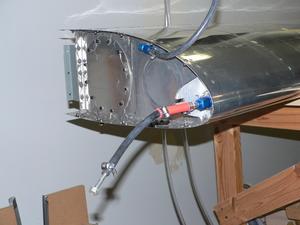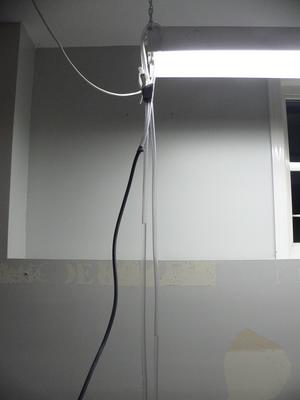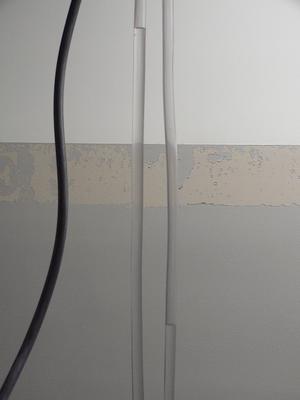I took Wednesday off, as it looked like the only day this week where it wouldn't rain or snow. It was cloudy, but cold, which allowed me to sand the fibreglas filler on the wheel pants outside. I almost froze to death, but at least I didn't make a mess in the garage.
 Today I put several coats of thinned resin on the sanded filler to seal it. Then I decided the Pro-seal on fuel tanks was cured well enough to chance a leak check. I cobbled together a hook up to a water manometer, and put about two feet of water pressure (about one psi) in the tank. The fuel cap was leaking. I put some duct tape over the fuel cap and tried again. The duct tape seemed to be stopping that leak, so I watched the water manometer level. It was slowly coming down, so I had a leak somewhere. Drat :(
Today I put several coats of thinned resin on the sanded filler to seal it. Then I decided the Pro-seal on fuel tanks was cured well enough to chance a leak check. I cobbled together a hook up to a water manometer, and put about two feet of water pressure (about one psi) in the tank. The fuel cap was leaking. I put some duct tape over the fuel cap and tried again. The duct tape seemed to be stopping that leak, so I watched the water manometer level. It was slowly coming down, so I had a leak somewhere. Drat :(
 I mixed up some soapy water, and started putting it on all the rivets, joints between sheet metal, etc. I spent about a half hour looking, but couldn't find the leak anywhere. I finally put some of the soapy water on the edges of the duct tape over the fuel cap, and found that it was still leaking. I tried all manner of ways to seal the fuel cap, but it would always leak. I checked the RV-List archives, and found that this is a very common problem. Some people keep plugging away until the cap stops leaking; others put the cap aside and use some other means to seal the tank filler hole for the leak test. The main purpose of the leak check is to confirm that there are no leaks in the rivet joints, etc, so there is some argument to put the fuel cap aside for now. In flight, there is normally no fuel against the fuel cap, so a small leak may not be critical.
I mixed up some soapy water, and started putting it on all the rivets, joints between sheet metal, etc. I spent about a half hour looking, but couldn't find the leak anywhere. I finally put some of the soapy water on the edges of the duct tape over the fuel cap, and found that it was still leaking. I tried all manner of ways to seal the fuel cap, but it would always leak. I checked the RV-List archives, and found that this is a very common problem. Some people keep plugging away until the cap stops leaking; others put the cap aside and use some other means to seal the tank filler hole for the leak test. The main purpose of the leak check is to confirm that there are no leaks in the rivet joints, etc, so there is some argument to put the fuel cap aside for now. In flight, there is normally no fuel against the fuel cap, so a small leak may not be critical.
 Tomorrow I'll try putting some grease on the fuel cap O-rings. If I can't get it to seal, I'll head to Home Depot to see what I can buy to seal the fuel filler hole.
Tomorrow I'll try putting some grease on the fuel cap O-rings. If I can't get it to seal, I'll head to Home Depot to see what I can buy to seal the fuel filler hole.